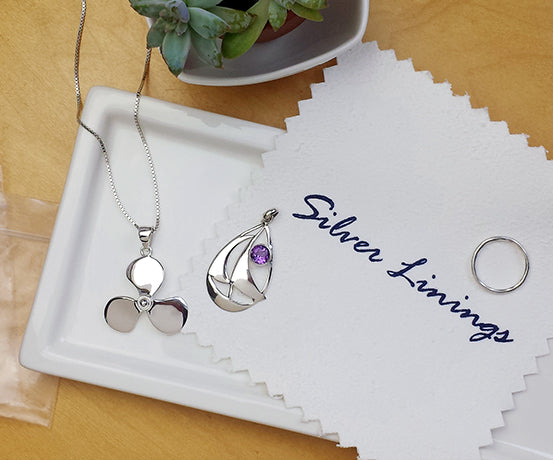How to Care for Your Jewelry

-
Wearing Sterling Silver
You should wear and enjoy your jewelry often, however, we recommend removing your jewelry before participating in certain activities.
GARDENING. Digging into a gardening project exposes jewelry to dirt, rocks, sand, and other rough materials that can scratch soft metal and gemstones. Using gardening tools is also hazardous to jewelry, especially rings and bracelets. Because gardening gloves can potentially loosen stones and prongs, it's best to simply remove jewelry altogether before gardening.
HOUSEWORK. Exposure to harsh chemicals and cleaning products can cause metals to break down. Because rubber gloves can potentially loosen stones and prongs, it's best to simply remove jewelry altogether before doing housework.
EXERCISING. Strenuous physical activity can put pressure on jewelry. In addition, jewelry is at a greater risk of falling off and getting lost.
SWIMMING. Remove jewelry before hopping into a pool or hot tub, as chlorine can be very damaging to metals and gemstones.
SHOWERING. Rings, earrings, and necklaces are especially susceptible to sliding off in the shower thanks to slippery suds, and often without us noticing. In addition, shampoo, conditioner, and body wash can leave a dull film on the surface of jewelry.
SLEEPING. Removing jewelry before bed is a good habit to get into. Keep a dish or small lidded box on the bedside table dedicated solely to storing your jewelry til morning.
When in doubt, remove your jewelry if it's precious to you. It's better to be safe than sorry.
Enough talk...let's shop!
-
Cleaning & Polishing Sterling Silver
Your sterling silver jewelry will need cleaning and polishing from time to time to remove fingerprints, oils, and naturally occurring tarnish.
Cleaning Sterling Silver
The most effective way to clean sterling silver is with warm water and mild bar soap. (Liquid soap is likely to leave a film on your jewelry, resulting in a dull finish.)
This cleaning method is safe for hard, non-porous gemstones, like topaz, amethyst, garnet, citrine, peridot, and cubic zirconia. Apply the warm, soapy water with a soft cloth or very soft toothbrush. Rinse clean and gently pat dry with a soft cloth.
Examples of porous gemstones include pearl, opal, emerald, turquoise, amber, coral, and onyx. Porous gemstones should never be soaked in water. If porous gemstones do become wet, gently pat dry and allow them to dry completely before storing. Take care not to expose porous gemstones to makeup, lotion, perfume, or hairspray.
Polishing Sterling Silver
The safest and most effective way to polish sterling silver jewelry is by using a soft polishing cloth. Silver polishing cloths are specially treated to remove tarnish and leave a high polished, lustrous shine.
Begin by gently rubbing the cloth on the surface of the silver, avoiding any gemstones. The dirt and tarnish on the jewelry will quickly transfer to the cloth. The more you use your polishing cloth, the darker it will become. Not to worry! Your polishing cloth will still be effective, even after many uses.
Avoid laundering your polishing cloth, as washing it will remove the cleaning agent from the fabric. A polishing cloth should last several years with normal use.
-
Storing Sterling Silver
Tarnish occurs on the surface of silver as a result of exposure to air and moisture. To slow the progression of tarnish, we recommend storing sterling silver jewelry in individual resealable plastic baggies. You may also choose to wrap individual pieces in soft tissue paper for added protection.
Organizing and storing jewelry items separately in bags prevents chains from tangling and gemstones from scratching each other and metal.
-
Questions
Still have questions about caring for your sterling silver jewelry? Contact us!
